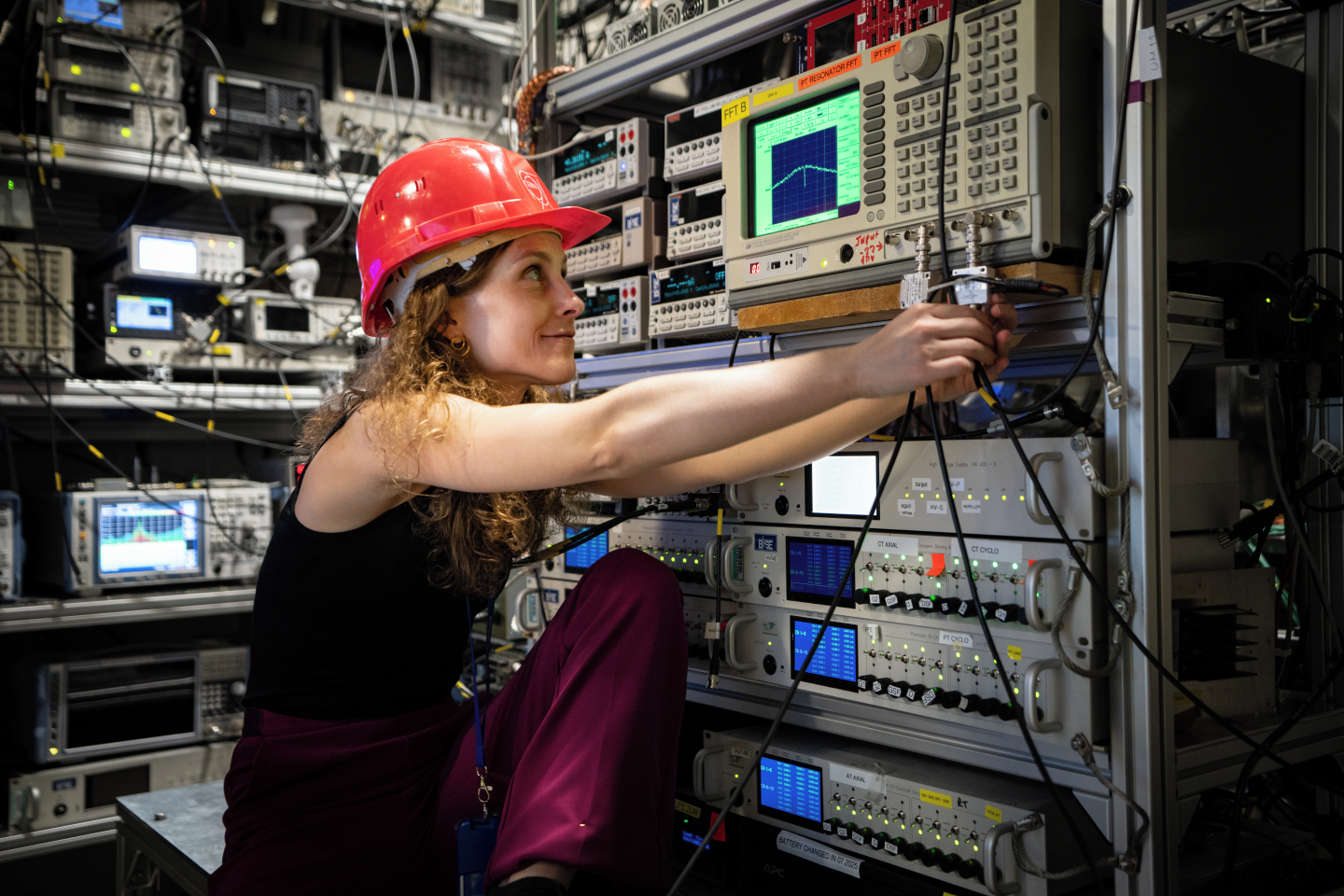
Physicist Barbara Latacz working in the BASE experiment (image: CERN)
In a breakthrough for antimatter research, the BASE collaboration at CERN has kept an antiproton - the antimatter counterpart of a proton - oscillating smoothly between two different quantum states for almost a minute while trapped. The achievement, reported in a paper published today in the journal Nature, marks the first demonstration of an antimatter quantum bit, or qubit, and paves the way for substantially improved comparisons between the behaviour of matter and antimatter.
Particles such as the antiproton, which has the same mass but opposite electrical charge to a proton, behave like miniature bar magnets that can "point" in one of two directions depending on their underlying quantum mechanical spin.
Measuring the way these so-called magnetic moments flip, using a technique called coherent quantum transition spectroscopy, is a powerful tool in quantum sensing and information processing. It also enables high-precision tests of the fundamental laws of nature, including charge-parity-time symmetry. This symmetry rules that matter and antimatter behave identically, which is at odds with the observation that matter vastly outweighs antimatter in the Universe.
Particles have quantum characteristics that defy our common sense, such as the characteristic of interfering with themselves, as demonstrated in the double slit experiment. Interactions with the surrounding environment can quickly suppress these interference effects through a process known as quantum decoherence. Preserving coherence is essential for controlling and tracking the evolution of quantum systems, like the transitions between the spin states of a single antiproton.
Although coherent quantum transitions have been observed before in large collections of particles and in trapped ions, they have never been seen for a single free nuclear magnetic moment - despite the latter featuring prominently in physics textbooks. The BASE collaboration has now achieved this at CERN's antimatter factory.
In some respects, the feat can be likened to pushing a child on a playground swing. With the right push, the swing arcs back and forth in a perfect rhythm. Now imagine that the swing is a single trapped antiproton oscillating between its spin "up" and "down" states in a smooth, controlled rhythm. The BASE collaboration has achieved this using a sophisticated system of electromagnetic traps to give an antiproton the right "push" at the right time. And since this swing has quantum properties, the antimatter spin-qubit can even point in different directions at the same time when unobserved.
The BASE experiment studies antiprotons produced at CERN's antimatter factory by storing them in electromagnetic Penning traps and feeding them one by one into a second multi-trap system to, among other things, measure and change their spin states. Using this set-up, the BASE collaboration has previously been able to show that the magnitudes of the magnetic moments of the proton and antiproton are identical within a just few parts-per-billion. Any slight difference in their magnitudes would break charge-parity-time symmetry and point to new physics beyond the Standard Model of particle physics.
However, this previous result was based on an incoherent spectroscopy technique in which the quantum transitions were disturbed by magnetic field fluctuations and measurement interference. In a substantial upgrade of the experiment, these decoherence mechanisms were suppressed and eliminated, culminating in the first coherent spectroscopy of an antiproton spin. The BASE team has now accomplished this for a period - called spin coherence time - of 50 seconds.
"This represents the first antimatter qubit and opens up the prospect of applying the entire set of coherent spectroscopy methods to single matter and antimatter systems in precision experiments," explains BASE spokesperson Stefan Ulmer. "Most importantly, it will help BASE to perform antiproton moment measurements in future experiments with 10- to 100-fold improved precision."
While qubits are the basic building blocks of quantum computers, where they allow information to be stored not just in one of two states but via a potentially limitless superposition of those states, the antimatter qubit demonstrated by BASE is unlikely to have immediate applications outside fundamental physics.
An even bigger leap in the precision of antiproton measurements is expected using BASE-STEP, which was designed to allow trapped antiparticles to be transported by road to magnetic environments that are "calmer" than the antimatter factory. "Once it is fully operational, our new offline precision Penning trap system, which will be supplied with antiprotons transported by BASE-STEP, could allow us to achieve spin coherence times maybe even ten times longer than in current experiments, which will be a game-changer for baryonic antimatter research," says lead author of the paper Barbara Latacz.






